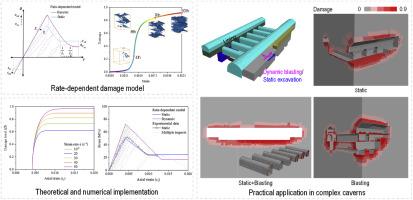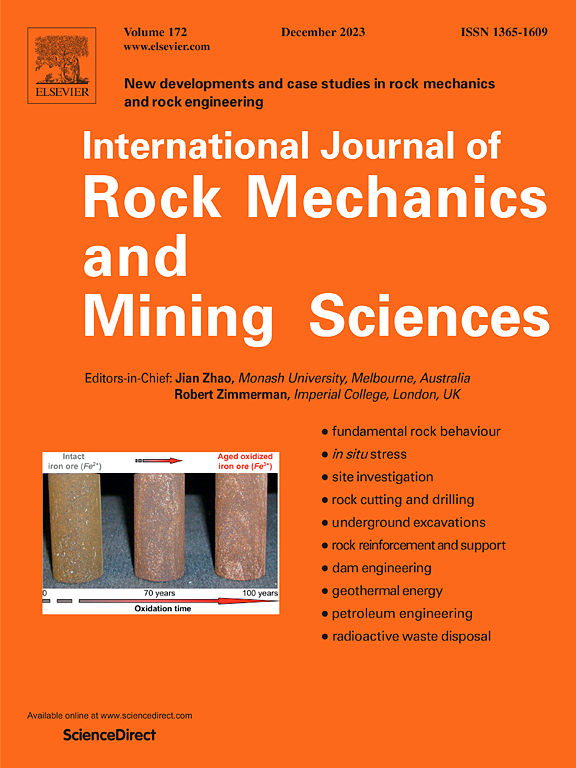开发动态累积损伤模型并将其应用于多次爆破下的地下水电洞穴
IF 7
1区 工程技术
Q1 ENGINEERING, GEOLOGICAL
International Journal of Rock Mechanics and Mining Sciences
Pub Date : 2024-11-04
DOI:10.1016/j.ijrmms.2024.105948
引用次数: 0
摘要
地下基础设施对于资源开采、能源储存和空间利用至关重要。构成这些结构的岩石和混凝土等地质材料会受到多轴应力的影响,并经常暴露在自然灾害和人类活动造成的动态极端载荷下。这些应力在施工阶段(包括钻孔和爆破挖掘等作业)和运营阶段(可能包括爆炸等事件)尤为显著。例如,虽然钻孔和爆破会在设计的开挖剖面内造成岩石破裂,但不可避免地会导致周围岩体形成破坏区。此外,连续开挖和多次爆破的累积效应会造成更大的破坏,从而威胁隧道结构在运营阶段的稳定性。本文强调了在静态和动态载荷下对这些现象进行全面分析以确保地下基础设施稳定性的重要性。为应对这些挑战,本文提出了一种与速率相关的土工材料损伤构成模型,用于评估爆破荷载的影响以及重复爆破造成的累积损伤。该模型的概念是使用加载-卸载曲线的强度包络线来表示反复冲击下逐渐累积的损伤。通过理论推导,建立了一个动态累积损伤模型,该模型基于修改后的莫尔-库仑应变软化模型,包含速率相关参数,并根据动态实验数据进行了验证。该模型捕捉了由临界应变速率阈值触发的静态应变软化与动态累积损伤之间的过渡。该模型的适用性通过隧道挖掘模拟得以证明,并强调了爆破载荷和损伤区累积的影响。为了评估模型的实际可行性,应用所开发的模型模拟了一个地下水电洞穴的不同开挖方案。围岩的破坏主要源于静态卸载和/或动态扰动。与静态开挖相比,爆破施工尤其会对隧道交叉区和两个台阶的连接区域造成严重破坏,导致位移增加,破坏程度更高。为了在保证工期的前提下减轻过度破坏,建议考虑连续交替进行动态加载和静态开挖卸载循环,这有助于了解关键区域的破坏形成情况,同时又不会严重耽误工程完工。本文章由计算机程序翻译,如有差异,请以英文原文为准。

Development of a dynamic cumulative damage model and its application to underground hydropower caverns under multiple blasting
Underground infrastructures are crucial for resource extraction, energy storage, and space utilisation. The geomaterials that make up these structures, such as rock and concrete, are subjected to multiaxial stress conditions and are frequently exposed to dynamic and extreme loadings caused by both natural disasters and human activities. These stresses are particularly significant during the construction phase, which involves operations such as drilling and blasting excavation, as well as during the operational phase, which may include events like explosions. For instance, while drilling and blasting induce rock breakage within the excavated profile as designed, they inevitably lead to the formation of a damage zone in the surrounding rock mass. Moreover, the cumulative effects of sequential excavations and multiple blasts can cause significantly greater damage, thereby threatening the stability of tunnel structures during the operation phase. This paper highlights the importance of thoroughly analysing these phenomena during both static and dynamic loadings to ensure the stability of underground infrastructures. To address these challenges, a rate-dependent damage constitutive model is proposed for geomaterials to assess the impacts of blasting loads and the cumulative damage resulting from repeated blasts. The model is conceptualised using the strength envelope of loading-unloading curves to represent the progressive accumulation of damage under repeated impacts. Through theoretical derivation, a dynamic cumulative damage model is developed, based on a modified Mohr-Coulomb strain-softening model incorporating rate-dependent parameters, and is validated against dynamic experimental data. The model captures the transition between static strain-softening and dynamic cumulative damage, triggered by a critical strain-rate threshold. The applicability of the model is demonstrated through simulations of tunnel excavation, emphasising the impact of blasting loads and the accumulation of damage zones. To assess its practical feasibility, the developed model is applied to simulate different excavation scenarios for an underground hydropower cavern. Damage in the surrounding rock mainly results from static unloading and/or dynamic disturbances. Blasting construction, in particular, causes significant damage in tunnel intersection zones and the connecting areas of two benches, leading to increased displacement and higher damage levels compared to static excavation. To mitigate excessive damage while maintaining the construction timeframe, it is recommended to consider alternating cycles of dynamic loading and static excavation unloading continuously, which helps understand damage formation in critical zones without significantly delaying project completion.
求助全文
通过发布文献求助,成功后即可免费获取论文全文。
去求助
来源期刊
CiteScore
14.00
自引率
5.60%
发文量
196
审稿时长
18 weeks
期刊介绍:
The International Journal of Rock Mechanics and Mining Sciences focuses on original research, new developments, site measurements, and case studies within the fields of rock mechanics and rock engineering. Serving as an international platform, it showcases high-quality papers addressing rock mechanics and the application of its principles and techniques in mining and civil engineering projects situated on or within rock masses. These projects encompass a wide range, including slopes, open-pit mines, quarries, shafts, tunnels, caverns, underground mines, metro systems, dams, hydro-electric stations, geothermal energy, petroleum engineering, and radioactive waste disposal. The journal welcomes submissions on various topics, with particular interest in theoretical advancements, analytical and numerical methods, rock testing, site investigation, and case studies.

 求助内容:
求助内容: 应助结果提醒方式:
应助结果提醒方式:


